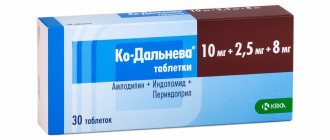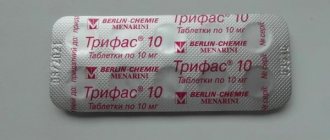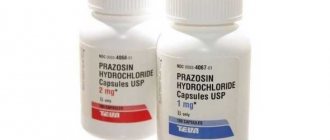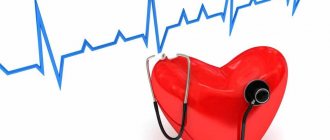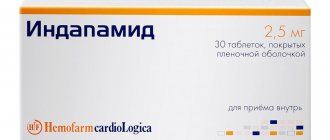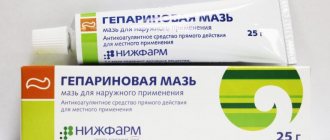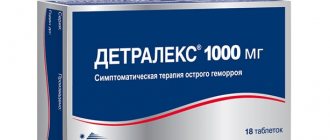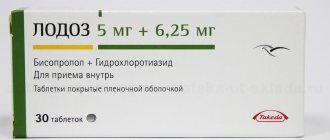Indications for use
for adults
Propranolol is used for the following pathologies:
- high blood pressure;
- arrhythmia;
- cardiac ischemia;
- pheochromocytoma;
- cirrhosis of the liver;
- cardiopsychoneurosis;
- hyperthyroidism;
- weakness of labor;
- hypertrophic cardiomyopathy;
- myocardial dystrophy;
- tachyarrhythmia;
- essential tremor;
- withdrawal state.
Propranolol can be used to prevent migraines.
for children
The drug is not used in pediatrics.
for pregnant women and during lactation
During pregnancy, propranolol can only be used under strict indications. It must be taken into account that it can have a negative effect on the fetus, causing intrauterine growth retardation, hypoglycemia, and bradycardia.
Propranolol is not compatible with breastfeeding.
Pharmacological properties
The medication belongs to the group of adrenergic blockers, since the main mechanism of action of Propranolol is to block beta-adrenergic receptors 1 and 2. Under its influence, the amount of cAMP produced from ATP, which is stimulated by catecholamines, decreases.
In this regard, there is a decrease in the number of calcium ions that enter the cells, and the ability to contract the heart muscle also decreases. The drug slows down and normalizes the pulse, has a depressing effect on excitability and conductivity.
At the very beginning of treatment with the drug, stable sympathetic stimulation of peripheral vessels and a moderate activation of the response to surges in blood pressure are observed. After a two-week course of treatment, the condition stabilizes, the heart rate decreases and normalizes, which improves myocardial perfusion and prolongs diastole.
Under the influence of propranolol, factors that provoke arrhythmia are eliminated - tachycardia, activation of the SNS (sympathetic nervous system), hypertension.
The drug reduces the myocardial oxygen demand, which reduces the severity of coronary artery disease. All this significantly affects the number of deaths after myocardial infarction.
Contraindications
Propranolol should not be taken if the patient has the following pathologies:
- bronchial asthma and COLD;
- severe form of bradycardia;
- peripheral circulatory disorders;
- arterial hypotension;
- sinoatrial and atrioventricular block;
- Raynaud's syndrome;
- unspecified and decompensated heart failure;
- cardiogenic shock;
- chronic liver pathologies;
- acidosis;
- acute myocardial infarction;
- individual intolerance to the composition of the medication.
Propranolol should not be taken in combination with MAO inhibitors, anesthetics that inhibit myocardial function, or during insulin therapy.
Propranolol analogs
Level 4 ATC code matches:
Sotalol Canon
Obzidan
Sotahexal
Sotalex
Anaprilin
Analogues and synonyms are medicines: Obzidan , Propranolol Hydrochloride , Opranol , Anaprilin , Tenomal , Inderal .
Applications and dosages
for adults
Propranolol is taken before meals.
The treatment regimen is selected by the doctor individually, depending on the specific diagnosis.
For high blood pressure, propranolol is prescribed 40 mg twice a day. If this dosage is not enough, then you need to drink 40 mg 3 times or 80 mg 2 times a day. The daily dosage should not exceed 320 mg.
For patients with angina pectoris, cardiac arrhythmia, propranolol is prescribed in an initial dosage of 20 mg 3 times a day, then the daily dosage is increased to 80-120 mg, which should be taken 2 or 3 times. The daily dosage for these pathologies should not exceed 240 mg.
For patients with essential tremor, as well as for the purpose of migraine prevention, β-adrenoblocker is prescribed 40 mg three times a day.
For thyrotoxicosis, propranolol is prescribed as an adjuvant, 40 mg 3-4 times a day.
In order to prevent recurrent myocardial infarction, treatment begins between 5 and 21 days after the myocardial infarction. For 2-3 days, propranolol is taken 40 mg 3 times a day, then 80 mg twice a day. If necessary, the daily dosage can be increased to 240 mg.
Patients suffering from impaired liver and kidney function should take a beta-blocker in a lower dosage.
In case of kidney disease, the time interval between taking the next dose of propranolol may be increased.
for children
The drug is not prescribed to persons under 18 years of age.
for pregnant women and during lactation
During therapy, propranolol is taken in minimally effective dosages.
Interaction
Extracts of allergens for skin testing, as well as allergens themselves used for immunotherapy , may increase the likelihood of developing severe systemic allergic reactions or anaphylaxis in patients taking Propranolol. X-ray contrast medications based on iodine when administered intravenously increase the risk of developing anaphylaxis . The likelihood of a drop in blood pressure and the severity of cardiodepressive effects increase with intravenous administration of phenytoin and inhaled medications for general anesthesia (hydrocarbon derivatives).
Propranolol affects the effectiveness of oral hypoglycemic agents, insulin , and is also able to mask symptoms of developing hypoglycemia such as hypertension and tachycardia. The medication increases the concentration of xanthines (an exception is difillin) and lidocaine in the blood plasma, reducing their clearance. This effect is more pronounced in patients with an initially high clearance of theophylline due to smoking. NSAIDs weaken the hypotensive effect of the drug (blockade of prostaglandin synthesis by the renal system, retention of sodium ions in the body).
Side effects
Taking the medication may cause the following side effects:
- decreased heart rate, heart failure, decreased blood pressure, AV block, decreased levels of leukocytes and platelets, thrombocytopenic purpura, impaired peripheral circulation;
- impotence, vertigo, headaches, insomnia, drowsiness, nightmares, decreased speed of mental and motor reactions, depression, emotional lability, agitation, excessive fatigue, short-term memory loss, hallucination, disorientation in space and time, weakness, sensitivity disorder;
- dry eye syndrome, visual impairment, keratoconjunctivitis;
- abdominal pain, loose stools, constipation, nausea, vomiting, impaired taste and liver function, ischemic colitis, mesenteric artery thrombosis;
- pathological hair loss, rashes, itching, hyperhidrosis, exacerbation of psoriasis, skin hyperemia, exanthema;
- laryngospasm, bronchospasm, pharyngitis, runny nose, nasal congestion, chest pain, cough, dyspnea, respiratory distress syndrome;
- increased activity of liver enzymes, lactadehydrogenase levels, bilirubin, decreased blood sugar levels;
- withdrawal syndrome, decreased libido, erectile dysfunction, Peyronie's disease, joint pain, decreased thyroid function, allergies, lupus syndrome, fever.
Manifestations of side effects
Taking the medication may cause side effects:
- nervous system: sleepiness, fatigue, nightmares, dizziness, lethargy, tremors of the limbs, paresthesia, depression, memory disorders, mental confusion, anxiety, headaches, muscle weakness, asthenic syndrome, imaginary visions;
- organs of perception: inflammation of the cornea and conjunctiva, eye diseases, decreased production of tear fluid, dry eyes, temporary blurred vision;
- heart and blood vessels: heart rhythm disturbance, cardiac conduction disturbance, rapid heartbeat, sinus rhythm disturbance, increased signs of heart failure, decreased myocardial contractility, chest pain, acute vascular dystonia, Raynaud's disease, cold legs, impaired blood microcirculation, decreased arterial pressure to critical levels, orthostatic collapse;
- digestive system: taste disturbance, liver dysfunction, cholestatic syndrome, jaundice, dark urine, indigestion, bloating, pain in the epigastric region, vomiting, dry mouth;
- respiratory organs: narrowing of the lumen of the small bronchi, involuntary contraction of the muscles of the larynx, respiratory failure, runny nose;
- endocrine system: decrease or increase in blood glucose, hypothyroidism;
- allergic reactions: nettle fever, skin rashes, itching, dermatosis, psoriasis-like changes, baldness, exanthema, redness of the skin, hyperhidrosis;
- laboratory indicators: increased activity of liver aminotransferases, lack of platelets, decreased number and level of leukocytes, increased level of bilirubin in the blood;
- impact on the intrauterine condition of the fetus: sinus rhythm disturbance, low glucose levels, developmental delay;
- other reactions: decreased libido, joint pain, back pain, withdrawal reaction, increased angina attacks.
Interaction with other drugs
When prescribing antidiabetic drugs during therapy, the likelihood of hypoglycemia increases. When prescribing propranolol and digitalis, severe bradycardia is possible.
When using inhalational anesthetics, haloperidol, during therapy, the likelihood of a drop in blood pressure and depression of myocardial function increases.
It is not recommended to drink amiodarone or verapamil while taking propranolol, since this combination increases the risk of arterial hypotension, bradycardia, asystole, ventricular fibrillation, and dyspnea.
Hydralazine and diltiazem increase the content of propranolol in the blood, which can cause severe bradycardia; doxorubicin increases the cardiotoxicity of the beta-blocker.
Propranolol may increase the concentration of warfarin, phenindione, and imipramine in the blood.
NSAIDs can weaken the antihypertensive effect of a beta-blocker, and clonidine, on the contrary, enhance it.
Propranolol cannot be combined with certain other medications, so the patient should report all medications they are taking.
Instructions for use of Propranolol
The non-selective adrenergic blocker Propranolol is used in the treatment of heart failure, hypertrophic cardiomyopathy, thyrotoxicosis and dystonia. It can be used to treat hemangioma. The drug contains the active substance of the same name and is produced by the German pharmaceutical company Weimer Pharma and the Russian factory Vector.
Composition and release form
The drug is available in the form of tablets, depot capsules and solution, sometimes sold under other names. Composition of medications:
| Pills | Capsules | Solution | |
| Description | White flat-cylindrical tablets | Yellow capsules | Transparent colorless liquid |
| Propranolol concentration, mg | 10.40 or 80 per piece. | 80 per piece | 0,1% |
| Auxiliary components | Talc, microcrystalline cellulose, corn starch, calcium stearate, colloidal silica, hypromellose | Gelatin | Water |
| Package | Blisters of 10 pcs., 5 blisters per pack | Blisters of 10 pcs., 3 or 5 blisters per pack | Ampoules 1 ml, 10 ampoules per box |
Mechanism of action of Propranolol
The principle of operation of the drug is based on the non-selective blocking of beta-adrenergic receptors, reducing the formation of cyclic adenosine monophosphate and reducing the flow of calcium ions into the cell when stimulated by catecholamines. Due to this, a negative inotropic effect is formed, myocardial contractility decreases, the pulse becomes less frequent, excitability and conductivity are inhibited.
The first day of treatment with Propranolol eliminates the stimulating effect of beta-adrenergic receptors on skeletal muscles, and increases the activity of alpha-adrenergic receptors. After three days of taking the tablets, the effect returns to its original levels. The hypotensive effect of the drug occurs due to sympathetic stimulation of peripheral vessels, a decrease in the sensitivity of baroreceptors in the aortic arch, and a decrease in the activity of the renin-angiotensin system. Stabilization of pressure occurs in the second week of treatment.
The antianginal effect of the drug is achieved by reducing the oxygen demand of myocardial tissue. Reducing the heart rate improves perfusion and prolongs diastole. The antiarrhythmic effect occurs due to the elimination of arrhythmogenic factors and a decrease in the rate of excitation of pacemakers. Suppression of impulse conduction was recorded in the anterograde (forward movement) direction.
Propranolol is included in the second group of antiarrhythmic drugs. It reduces post-infarction mortality, prevents the development of headaches and the severity of tremor. Increased dosages of the drug increase the atherogenic properties of the blood, cause a sedative effect, increase the tone of the bronchi and increase the contraction of the uterine walls while taking medications that stimulate the myometrium.
Indications for use
The use of the drug has a wide range of indications. The main areas are diseases of the cardiovascular system:
- angina pectoris;
- arterial hypertension;
- sinus tachycardia;
- unstable angina;
- atrial fibrillation;
- supraventricular tachycardia;
- myocardial infarction;
- alcohol withdrawal;
- ventricular extrasystole;
- essential tremor;
- thyrotoxic crisis;
- diffuse toxic goiter;
- sympathoadrenal crises;
- pheochromocytoma;
- anxiety.
special instructions
During therapy, exacerbation of psoriasis is possible.
After long-term treatment, the dosage of the medication should be reduced gradually under the supervision of a physician.
For patients suffering from pheochromocytoma, propranolol can be prescribed after a course of α-blockers.
A few days before using anesthesia, the β-blocker should be discontinued or an anesthetic drug that has minimal negative inotropic effect should be selected.
During therapy, caution should be exercised when driving.
Farm dossier
In the Latin recipe, Propranolol is written – Propranololi. The main active ingredient of this medication is propranolol hydrochloride, which is a white or almost white powder in crystalline form. It dissolves in alcohol and water. The main form of implementation is tablets. Each tablet, depending on the manufacturer’s decision, may contain a different dosage of the active substance. Among the options: 10, 40, 80 and 160. The doctor makes a prescription for the patient and advises in what dosage to purchase the medicine. If you haven’t found a suitable one, then you need to compare the given dosage with the one indicated on the package.
What additional components are included in the drug formula depends on the manufacturer.
For a complete list of ingredients, read the instructions for use of Propranolol - this is important if you are allergic to one or another component (for example, lactase intolerance, which may well be part of the medication).
Overdose
If recommended dosages are exceeded, the following signs of drug poisoning may occur:
- decreased heart rate;
- drop in blood pressure;
- dizziness, which may result in fainting;
- arrhythmia;
- difficulty breathing;
- convulsions;
- cyanosis of fingers and palms.
If there is a pronounced decrease in heart rate, atropine and epinephrine are administered intravenously. If their effectiveness is low, a pacemaker is temporarily indicated. If the victim experiences ventricular extrasystole, lidocaine is prescribed. When blood pressure decreases and in the absence of symptoms of pulmonary edema, plasma-substituting solutions are administered intravenously; if they are ineffective, epinephrine, dopamine, and dobutamine are prescribed. If bronchospasm occurs, β2-adrenergic agonists and theophylline are administered inhalation or parenterally.
Composition and release form
The trade name of propranolol in tablet form is Anaprilin.
Previously, Propranolol hydrochloride was also produced. An oral solution containing propranolol is called Hemangiol. Anaprilin (propranolol) is available in two dosages of 0.01 and 0.04 mg.
Properties
Propranolol and analogs have the following effects in the body:
- reduce blood pressure (antihypertensive effect);
- increase blood flow to the heart and reduce its need for oxygen (antianginal);
- restore heart rhythm (antiarrhythmic).
Additional effects:
- prevent the development of headaches of vascular origin;
- reduce tremor;
- increase atherogenic (promoting the development of atherosclerosis) properties of blood;
- increase uterine contraction;
- increase bronchial tone;
- in high doses cause a sedative effect;
- reduce foci of infantile hemangioma.
Analogs
Propranolol can be replaced with the following medications:
- Obzidan is an original medicine containing propranolol. It has confirmed its effectiveness in clinical trials. The medicine is available in tablets, which are contraindicated for children and measles patients. During pregnancy, the medicine can be taken only if the benefit to the mother outweighs the harm to the fetus; the drug should be discontinued 2-3 days before the expected birth.
- Anaprilin contains propranolol as an active ingredient. The medicine is produced by several companies. The drug is sold in tablets of 10 mg and 40 mg. They are contraindicated for persons under 18 years of age and mothers supporting breastfeeding. During pregnancy, it can be prescribed according to strict indications.
- Gemangiol contains propranolol as an active substance. The medicine is produced in the form of an oral solution, which is convenient for patients who have difficulty swallowing tablets. Hemangiol should not be prescribed to persons under 18 years of age or to breastfeeding patients. During pregnancy, the solution can be taken when the benefit to the woman outweighs the potential harm to the fetus.
- Egilok Retard is used for the same pathologies as propranolol. The medication is available in tablets with a slow release of the active substance, which allows you to take it once a day. The medicine can be prescribed to adult patients, including pregnant women.
Propranolol
Abiraterone. It is recommended to prescribe abiraterone with caution to patients receiving propranolol (metabolized through the CYP2D6 system, has a narrow therapeutic index). In such cases, a reduction in the dose of propranolol should be considered.
Agomelatine. Caution should be exercised when administering agomelatine concomitantly with propranolol (a moderate inhibitor of the CYP1A2 isoenzyme) until sufficient clinical experience has been gained.
Amiodarone. When amiodarone is used concomitantly with propranolol, the risk of developing or worsening bradycardia, AV block, cardiac arrest and heart failure increases.
Amiodarone. With amiodarone (which has weak beta-blocking activity), the risk of excessive hypotension and bradycardia increases.
Articaine + Epinephrine. The simultaneous use of the combination of articaine + epinephrine with propranolol is contraindicated due to the risk of developing a hypertensive crisis and severe bradycardia.
Atracuria besilate. Propranolol, when used in combination with atracurium besylate, enhances neuromuscular blockade and can intensify or unmask latent myasthenia gravis or cause myasthenic syndrome, which can lead to the development of hypersensitivity to atracurium besylate.
Acetylsalicylic acid. Acetylsalicylic acid weakens the hypotensive effect of propranolol (a consequence of inhibition of PG synthesis in the kidneys with a decrease in renal blood flow and sodium and fluid retention).
Belladonna leaf extract + Benzocaine + Metamizole sodium + Sodium bicarbonate. The effect of the combination of belladonna leaf extract + benzocaine + metamizole sodium + sodium bicarbonate is enhanced by propranolol (slows down inactivation).
Belladonna leaf extract + Caffeine + Paracetamol + Theophylline + Phenobarbital + Cytisine + Ephedrine. Propranolol increases the concentration of theophylline (in the combination of belladonna leaf extract + caffeine + paracetamol + theophylline + phenobarbital + cytisine + ephedrine) in the blood and therefore may increase the risk of developing its side effects.
Bendazole + Metamizole sodium + Papaverine + Phenobarbital. Combination with propranolol enhances the hypotensive effect of the combination of bendazole + metamizole sodium + papaverine + phenobarbital.
Benzathine benzylpenicillin. It increases the content of the free fraction in plasma, since, having a greater ability to bind to proteins, it displaces it from the sites of fixation.
Betaxolol. Propranolol enhances (mutually) the effects. Beta-blockers prescribed orally, incl. propranolol, together with beta-blockers used in ophthalmology (eye drops), incl. betaxolol, enhance the reduction of IOP; in this case, the effects of systemic blockade of beta-adrenergic receptors, as a rule, increase.
Bisoprolol. Mutually enhances the effects; combined use is contraindicated.
Bromhexine + Guaifenesin + Salbutamol. It is not recommended to use the combination of bromhexine + guaifenesin + salbutamol simultaneously with propranolol.
Bromhexine + Guaifenesin + Salbutamol + Racementol. It is not recommended to use the combination of bromhexine + guaifenesin + salbutamol + racementol simultaneously with propranolol.
Bupivacaine + Epinephrine. When used in combination, propranolol, a non-cardioselective beta-blocker, enhances the pressor effect of epinephrine (as part of a combination of bupivacaine + epinephrine), which can lead to severe hypertension and bradycardia.
Warfarin. Propranolol, when used in combination, prolongs the anticoagulant effect of warfarin.
Warfarin. Propranolol increases the effect of warfarin.
Verapamil. Concomitant use of propranolol and intravenous administration of verapamil is contraindicated.
Verapamil. Propranolol enhances (mutually) the effect and can increase the negative effect on heart rate, AV conduction and/or cardiac contractility, causing severe bradycardia, AV block (up to complete). Against the background of verapamil, clearance decreases.
Hydralazine. The combined use of propranolol with hydralazine increases the risk of an excessive decrease in blood pressure.
Hydrochlorothiazide. Strengthens (mutually) the antihypertensive effect.
Hydrochlorothiazide + Captopril. The combination of hydrochlorothiazide + captopril increases the bioavailability of propranolol and enhances (mutually) the effects.
Glimepiride. Propranolol increases (by 20%) Cmax, AUC and T1/2. Enhances the effect.
Glipizide. Propranolol enhances the effect. When used in combination, dose adjustment may be required.
Glucagon. Administration of glucagon against the background of propranolol can lead to severe tachycardia and increased blood pressure.
Guanfacine. When guanfacine is used concomitantly with propranolol, the risk of developing or worsening bradycardia, AV block, cardiac arrest and heart failure increases.
Dextromethorphan + Paracetamol + Pseudoephedrine + [Ascorbic acid]
Propranolol, when used in combination, may enhance the vasoconstrictor effect of pseudoephedrine (as part of the combination dextromethorphan + paracetamol + pseudoephedrine + [ascorbic acid]).
Digoxin. Strengthens (mutually) the inhibition of AV conduction.
Diltiazem. Concomitant use of propranolol and intravenous administration of diltiazem is contraindicated.
Diltiazem. Strengthens (mutually) the negative chrono-, ino- and dromotropic effects. Against the background of diltiazem, the bioavailability of propranolol increases.
Dobutamine. Reduces (mutually) cardiac effects. Against the background of dobutamine, an increase in peripheral vascular resistance is possible.
Dronedarone. In clinical studies, bradycardia was observed more frequently with the combination of dronedarone and propranolol.
It is recommended to use propranolol with caution in combination with dronedarone due to pharmacokinetic and possible pharmacodynamic interactions (risk of additive inhibitory effects on the sinus and AV nodes). It is necessary to start treatment with metoprolol with low doses and increase their dose only under ECG monitoring. In patients already receiving propranolol, the addition of dronedarone should be monitored by ECG and the dose of propranolol adjusted if necessary.
Indapamide. Strengthens (mutually) the antihypertensive effect.
Interferon alpha. Combined use with interferon alfa in the form of an injection solution may lead to changes in the metabolism of propranolol.
Interferon alpha-2b. Interferon alfa-2b is able to reduce the activity of cytochrome P450 and, therefore, interfere with the metabolism of propranolol.
Captopril. Propranolol enhances the (mutually) hypotensive effect.
Clonidine. The combined use of propranolol with clonidine increases the risk of an excessive decrease in blood pressure.
Levothyroxine sodium. Reduces the activity of T4 5-deiodinase, although the levels of T3 and T4 change slightly. Against the background of levothyroxine sodium (when hypothyroidism turns into a euthyroid state), the effect may be weakened.
Lidocaine. Propranolol, when used in combination, reduces the clearance of lidocaine and increases its concentration in plasma.
Lidocaine. Propranolol reduces the hepatic clearance of lidocaine (decreased metabolism due to inhibition of microsomal liver enzymes and decreased hepatic blood flow) and increases the risk of toxic effects.
Lidocaine + Chlorhexidine. Propranolol reduces the hepatic clearance of lidocaine (as part of a combination of lidocaine + chlorhexidine in the form of a topical spray) - decreased metabolism due to inhibition of microsomal oxidation and decreased hepatic blood flow - and increases the risk of toxic effects (including drowsiness, drowsiness, bradycardia, paresthesia, etc.).
Lorazepam. When used in combination, propranolol increases plasma levels of lorazepam.
Maprotiline. Maprotiline is metabolized primarily by the CYP2D6 isoenzyme. Concomitant use of maprotiline with the beta-blocker propranolol, which is an inhibitor of the CYP2D6 isoenzyme, may lead to an increase in the plasma concentration of maprotiline. In such cases, it is recommended to monitor the plasma concentration of maprotiline and adjust the dose if necessary.
Metamizole sodium. Propranolol slows down biotransformation and increases the effect of metamizole sodium.
Metamizole sodium + Pitophenone + Fenpiverinium bromide. When used together, propranolol (slows down the inactivation of metamizole sodium) enhances the effect of the combination of metamizole sodium + pitofenone + fenpiverinium bromide.
Metamizole sodium + Triacetonamine-4-toluenesulfonate. Propranolol slows down the inactivation of metamizole sodium (as part of the combination metamizole sodium + triacetonamine-4-toluenesulfonate) and enhances its effect.
Metamizole sodium + Quinine. Propranolol enhances the effect of the combination of metamizole sodium + quinine.
Methyldopa. When propranolol is used concomitantly with methyldopa, the risk of developing or worsening bradycardia, AV block, cardiac arrest and heart failure increases.
Methyldopa. Propranolol enhances the (mutually) antihypertensive effect.
Mivacurium chloride. Propranolol enhances the effect, incl. the ability to unmask and increase the severity of myasthenia gravis.
Naproxen. The antihypertensive effect of propranolol is weakened by naproxen.
Naproxen + Esomeprazole. Naproxen (as part of the naproxen + esomeprazole combination) may reduce the antihypertensive effect of propranolol.
Nitroglycerine. Strengthens (mutually) the hypotensive effect.
Nifedipine. The simultaneous use of propranolol and nifedipine can lead to a significant decrease in blood pressure.
Octreotide. With octreotide, the likelihood of developing severe bradycardia, arrhythmias and conduction disturbances increases.
Pasireotide. It is recommended to monitor heart rate when prescribing pasireotide to patients receiving propranolol, which causes bradycardia, as concomitant therapy.
Pentaerythrityl tetranitrate. When used in combination, propranolol enhances the antianginal effect of pentaerythrityl tetranitrate.
Pilocarpine. Against the background of systemic action of pilocarpine, the risk of conduction disorders increases.
Pyridostigmine bromide. When used in combination, propranolol weakens the effects of pyridostigmine bromide.
Piroxicam. Against the background of piroxicam, the hypotensive effect is weakened, although the concentration of the free fraction in plasma increases (it is displaced from protein binding).
Propaphenone. Against the background of propafenone (CYP2D6 substrate), biotransformation is blocked, plasma concentration increases significantly, and T1/2 is prolonged.
Propylthiouracil. Against the background of propylthiouracil, the effects change; when administered in combination, a dose adjustment of propranolol may be required.
Reserpine. When reserpine is used concomitantly with propranolol, the risk of developing or worsening bradycardia, AV block, cardiac arrest and heart failure increases.
Repaglinide. Propranolol enhances the hypoglycemic effect; may camouflage some symptoms of hypoglycemia.
Risperidone. Strengthens (mutually) the antihypertensive effect.
Rifampicin. Rifampicin, when used in combination, shortens the T1/2 half of propranolol.
Rifapentine. Rifapentine may increase the metabolism and decrease the activity of propranolol; When used concomitantly with rifapentine, a dose adjustment of propranolol may be required.
Salmeterol. Propranolol weakens the effect; may cause bronchospasm in patients with asthma.
Simaldrat. Against the background of simaldrat, the absorption of propranolol decreases; when administered in combination, the interval between doses should be at least 2 hours.
Sulfasalazine. Sulfasalazine, when used in combination, increases the plasma concentration of propranolol.
Terazosin. Propranolol enhances the (mutually) hypotensive effect; with combined administration, a significant decrease in blood pressure is possible, requiring a dose reduction.
Terbutaline. Propranolol weakens the effect and can cause bronchospasm in patients with asthma.
Thiamine. Thiamine, when used in combination, reduces the pharmacological activity of propranolol.
Thioridazine. Concomitant use of propranolol (100-800 mg daily) and thioridazine causes an increase in plasma levels of thioridazine (approximately 50-400%) and its metabolites (approximately 80-300%); Concomitant use of propranolol and thioridazine should be avoided.
Trifluoperazine. With the simultaneous administration of trifluoperazine with propranolol, an increase in the concentration of both drugs is observed.
Ubidecarenon. Concomitant use of propranolol may lead to a decrease in plasma concentrations of ubidecarenone.
Felodipine. Felodipine increases the bioavailability of propranolol; when used in combination, propranolol enhances the hypotensive effect of felodipine.
Phenylephrine. Propranolol may have an unpredicted increase in the hypertensive effect (one report reported a sharp rise in blood pressure).
Phenytoin. The combined use of propranolol with phenytoin increases the severity of the cardiodepressive effect and the risk of lowering blood pressure.
Fluvoxamine. Fluvoxamine, when used in combination, increases the concentration of propranolol in the blood plasma.
Fluvoxamine. Against the background of fluvoxamine, the plasma level of propranolol increases (5 times).
Fosinopril. With simultaneous use, propranolol enhances the hypotensive effect of fosinopril. The bioavailability of fosinopril does not change when used concomitantly with propranolol.
Cimetidine. Cimetidine, when used in combination, increases the concentration of propranolol in plasma.
Cisatracurium besylate. When used in combination, propranolol enhances the effect of cisatracurium besylate. In rare cases, propranolol can worsen the course or promote the manifestation of latent myasthenia gravis, as well as cause myasthenic syndrome; as a result, increased sensitivity to cisatracurium besylate may occur.
Ethanol. The combined use of propranolol with ethanol increases the risk of central nervous system depression.
Propranolol prolongs life and reduces mortality from recurrent heart attack and stroke
Beta-blockers (preferably non-selective - propranolol or carvedilol) are indirect mTOR inhibitors. Substances that can inhibit mTOR are candidates for the role of anti-aging drugs. It is the mTOR gene that plays one of the leading roles, thanks to which reducing caloric intake can prolong life.
In addition, propranolol suppresses stress through blockade of receptors for stress hormones. Stress greatly shortens our life and accelerates aging, creates wrinkles, raises blood pressure, damages the heart and blood vessels, shortens telomeres, and reduces the level of longevity protein Klotho.
The fact that emotional stress increases blood pressure and causes heart disease is clearly shown in the work of J. Kaplan. Using primates as an example, Kaplan showed that if you gather a group of male primates, then within a few days the monkeys will develop a social hierarchy. The worst place in such a hierarchy is at the bottom. Male primates in subordinate positions exhibit a range of indicators of chronic stress. Often such primates develop atherosclerosis. But if scientists gave male primates at the bottom of the social hierarchy (at risk) beta blockers, which suppress the activity of the sympathetic nervous system, then they did not develop vascular atherosclerosis. This showed how the sympathetic nervous system, due to stress, negatively affects the development of atherosclerosis and is involved in problems with the heart and blood vessels. The truth is that emotional stress manifests itself through the sympathetic (adrenergic) autonomic nervous system, which connects the control centers of our brain and internal organs. Including immune, bone marrow, etc. And atherosclerosis is the main factor that leads to the largest number of deaths in developed countries from heart attack and cerebral stroke.
Link to the study:
- www.ncbi.nlm.nih.gov/pubmed/2899392
Clinical trials in humans have shown that propranolol reduces mortality from cardiovascular disease (the No. 1 cause of death in the world),
Link to the study:
- www.ncbi.nlm.nih.gov/pubmed/6342840
A 3-year observation of patients aged 60-69 years who suffered a myocardial infarction showed that propranolol reduced overall mortality in such patients by 23-37%. In addition, propranolol caused a decrease in signs of heart disease and aging (a significantly greater increase in left ventricular ejection fraction and a significantly greater decrease in left ventricular myocardial mass.
Links to the study:
- www.ncbi.nlm.nih.gov/pubmed/9230162
- www.ncbi.nlm.nih.gov/pubmed/6342843
- https://pda.rlsnet.ru/mnn_index_id_370.htm
- www.ncbi.nlm.nih.gov/pubmed/6342840
- www.ncbi.nlm.nih.gov/pubmed/3903736
- www.ncbi.nlm.nih.gov/pubmed/10381708
In animal studies, the lipophilic metaprolol administered daily starting at 12 months of age extended the median lifespan of long-lived male mice by 10% (www.ncbi.nlm.nih.gov/pubmed/23314750). A 2020 meta-analysis of 90,935 patients concluded that lipophilic beta-blockers (metoprolol, propranolol, and oxyprenolol) were significantly better at reducing the risk of CVD mortality than hydrophilic beta-blockers (atenolol, etc.) (www.ncbi.nlm.nih) .gov/pubmed/28760243). Atenolol (a hydrophilic beta-blocker) is associated with an increased risk of stroke in older adults, whereas lipophilic beta-blockers, mainly metoprolol and propranolol (moderate to highly lipophilic) do not increase the risk of stroke in this population. In addition, drugs with high lipophilicity may more easily penetrate the brain and cell membrane, which may help prevent stroke and cardiac mortality, indicating that beta blockers with moderate to high lipophilicity may have a greater impact on clinical outcomes than hydrophilic ones beta blockers.
Currently, propranolol is being considered for the treatment of resistant hypertension, together with other blood pressure medications, when other medications are insufficient to control blood pressure.
Link to the study:
- www.ncbi.nlm.nih.gov/pubmed/28292320

